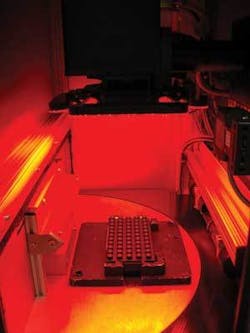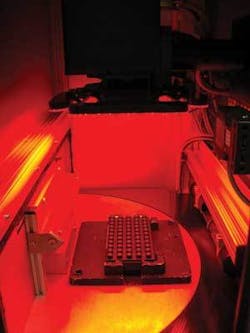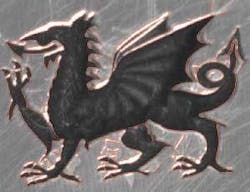Marking with vision
A through-the-lens vision system improves quality and accuracy for laser marking/engraving applications
Linda McIntosh and Faycal Benayad-Cherif
Camera systems have been used to inspect components, verify parts presence, and read alphanumeric characters for many years. With the “drive” to improve quality control and profitability in today’s competitive world, companies need to find ways to reduce waste, increase product throughput, and improve the overall manufacturing cost. Laser manufacturers and users have looked at ways to integrate a camera into their laser marking and engraving processes to help do just that.
Among the many third-party vision systems for laser markers, several have drawbacks that can reduce product throughput, create their own mark placement inaccuracies, and reduce mark precision. These obstacles occur, in part, because they are not an integral part of the marking system. Cameras have been mounted in different locations close to the laser marking system so that the part being marked can be inspected for the following: verification of the type of part, confirmation of part positioning on a work table, and verification that the part has been marked.
FOBA, A Virtek Company, has developed IMP (Intelligent Mark Positioning) an integrated, through-the-lens vision system, which has achieved part verification functionality and has also achieved additional benefits for which it was not initially created.
Today, IMP can reduce set-up time, aid in focusing the output lens, dramatically improve mark placement accuracies, and minimize, if not eliminate, incorrect mark content on a part, thus reducing waste parts. In addition, through-the-lens vision accepts the use of loose fixtures while achieving part positioning with extreme accuracy; a significant overhead cost many manufacturers will gladly miss.
IMP has achieved beneficial results in the medical device, automotive, and mint industries where parts can be expensive and mark placement is crucial.
Medical device industry
Laser marking implantable bone screws presents many challenges, including the positioning of small characters in a very limited area and the ability to do this repeatedly without the operator adjustment of the laser parameters. Bone screws are manufactured in many sizes that, at first glance, can look the same, so it is critical to confirm the bone screw type to ensure that the correct information is marked for that particular part. Failure to do so can result in a huge loss of revenue for the manufacturer.
A typical laser application, marking radial text with a character height of 0.05mm on a 3mm diameter screw head, is a common challenge. The medical device manufacturer must be able to produce a readable and reproducible mark on all bone screws, which will result in minimizing wasted parts. This is important as medical devices are very expensive.
The code positioning and quality of mark on screw heads must be reproducible to eliminate any procedural adjustment by the operator. This is critical as any adjustment in laser parameters would result in revalidating the procedure. Precise positioning of the mark in the target area without expensive fixturing can also reduce overall production costs.
Results have shown that the IMP is able to develop a vision model to identify a screw head location and mark reproducibly. This achievement has allowed operators to significantly reduce the revalidation and marking procedures, which can take up to 80 percent of their production time. Product throughput is dramatically improved, waste parts are virtually eliminated due to unreadable marking, and a simple fixture can be utilized for the screws. Another benefit is a significant reduction in setup time, which offers an additional reduction in costs. Marking repeatability on bone screws is typically better than 25 µm.
The IMP is able to differentiate small features within the part such as the start point of the set screw thread, and it can be used to orient a mark on an otherwise symmetrical screw. It also can pick up different features on a part and use this to reject a part resulting in a “no mark.” Laboratory testing has demonstrated that IMP can track part variations on the order of a few micrometers. This feature has been used to compensate for part variations associated with manufacturing processes.
Day/night marking
An advantageous IMP application in the automotive industry is marking on day/night buttons. Previously, manufacturers of automotive buttons had to place the parts on a tray and then mark them using a multiple part layout that resides in the laser marking software. In many cases, the buttons would be placed incorrectly in the tray resulting in improper mark positioning. Trays are spray painted many times and, after repeated use, the position of the buttons in the tray and the tray would shift and rotate in a random pattern. Trays are typically made of ABS, which can flex and contribute to placement inaccuracies. The combination of these variations can cause parts to shift by as much as 4 mm. “Implementation of IMP with our FOBA Vario Marking System has allowed us to use a simple plastic support,” states Abel Vieira, laser process engineer from Key Plastics in Portugal. The challenge is to utilize the IMP capabilities to position the mark within acceptable tolerance limits.
Production of waste parts from marking a pattern on the wrong part along with all of the above issues had to be addressed by many companies. To meet the automotive part manufacturer’s requirements, IMP had to accurately laser mark a pattern on buttons with varying orientation and angles, meet tight processing times to ensure high productivity, and to set up a procedure in which the vision system could determine acceptance criteria for print/no print to minimize significant waste. Vieira is extremely pleased with the improvement in accuracy that he has achieved. “We have reduced our wasted parts by better than 90 percent compared to our laser system without IMP.” Figure 1 displays a typical tray of buttons from Key Plastics marked with IMP and the FOBA Vario RD50.
By developing a model of the part, the IMP can capture and align the mark to the button. It can also set up acceptable criteria to mark or reject the part. The IMP was able to maintain product throughput and significantly reduce scrap parts and inspection time when compared to using a non-IMP laser.
A typical acceptance criteria set out by an automotive parts manufacturer and the corresponding IMP results are shown in Table 1.
One final consideration for determining the feasibility of using IMP for automotive button marking is based on the asymmetry of the part and features that are present. This is essential in achieving good part positioning and correct orientation. Figure 2 shows different button styles and their suitability with IMP.
Laser texturing
In the development of molds and dies for the mold and coin industries, it is critical to produce textures in the correct position. Texturing or frosting around intricate details can be accomplished without masking and sand blasting, significantly reducing the time to prepare the part.
In Figure 3, a sample chip with existing features is captured by the IMP of a laser system to determine the area to be textured. A magnified view of the results can be seen in Figure 3b, which demonstrates the effectiveness of using IMP.
Fixturing is not needed to frost the chip because the vision system used the dragon’s profile as a registration feature to perfectly identify the laser texturing area. The camera’s field of view allows the coin to have a 10-degree rotation variation, and the positioning can vary by more than 4 mm without effecting the results or significantly increasing cycle time. This was achieved without any loss of chips due to inconsistencies.
Table 2 shows the performance achieved using IMP based on one customer’s requirements.
FOBA, A Virtek Company, has achieved a truly integrated, through-the-lens vision system with the laser marker. Part verification, mark content, and laser control are performed under one platform. IMP can reduce set-up time, simplify focusing, eliminate (or reduce) waste parts due to misaligned marks, reduce the price of costly fixturing, offer superior, accurate mark placement, and reduce operator error.
Linda McIntosh ([email protected]) is product marketing manager and Faycal Benayad-Cherif, is IMP product manager for FOBA, A Virtek Company (www.virtek.ca; Waterloo, Ontario).





